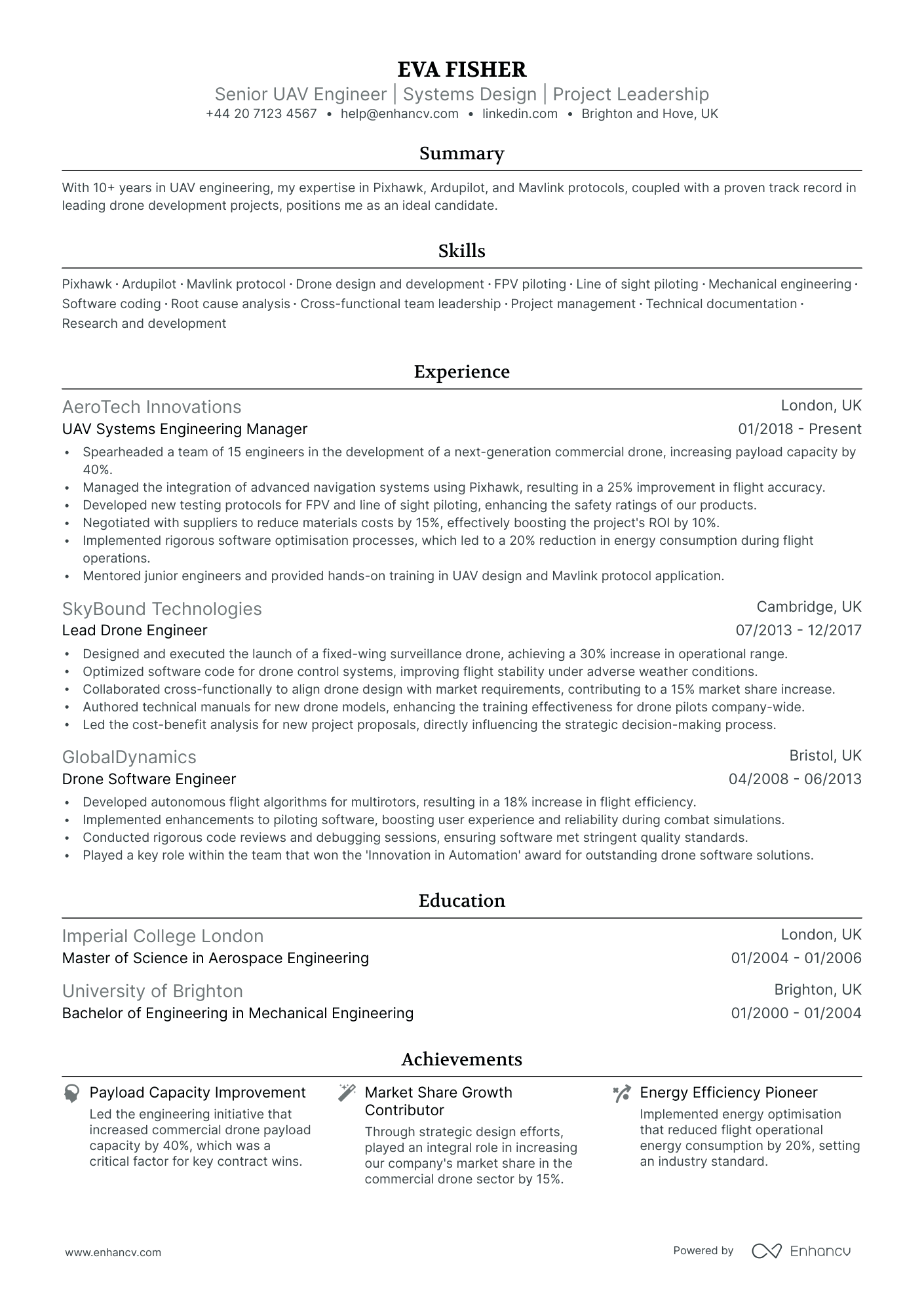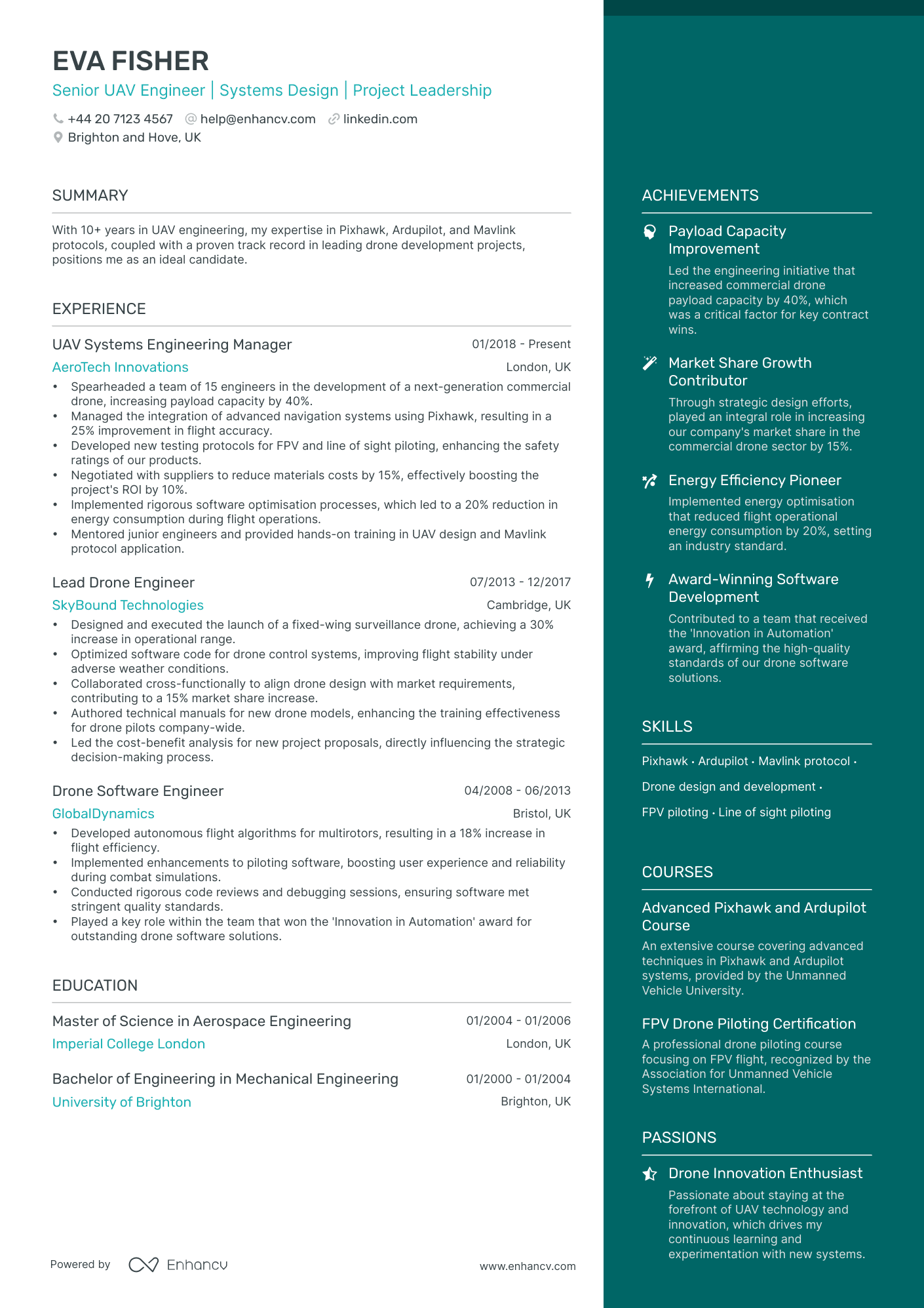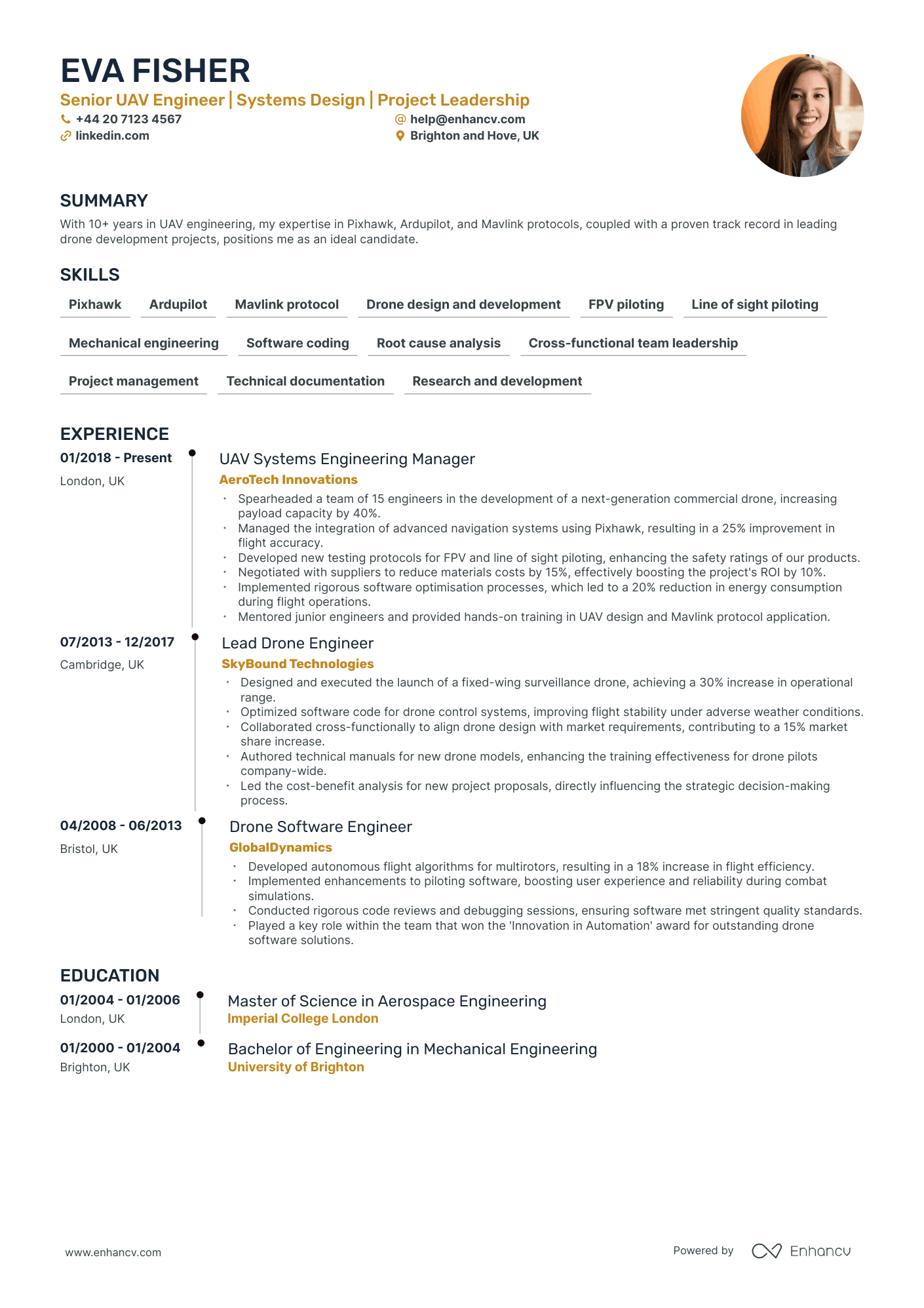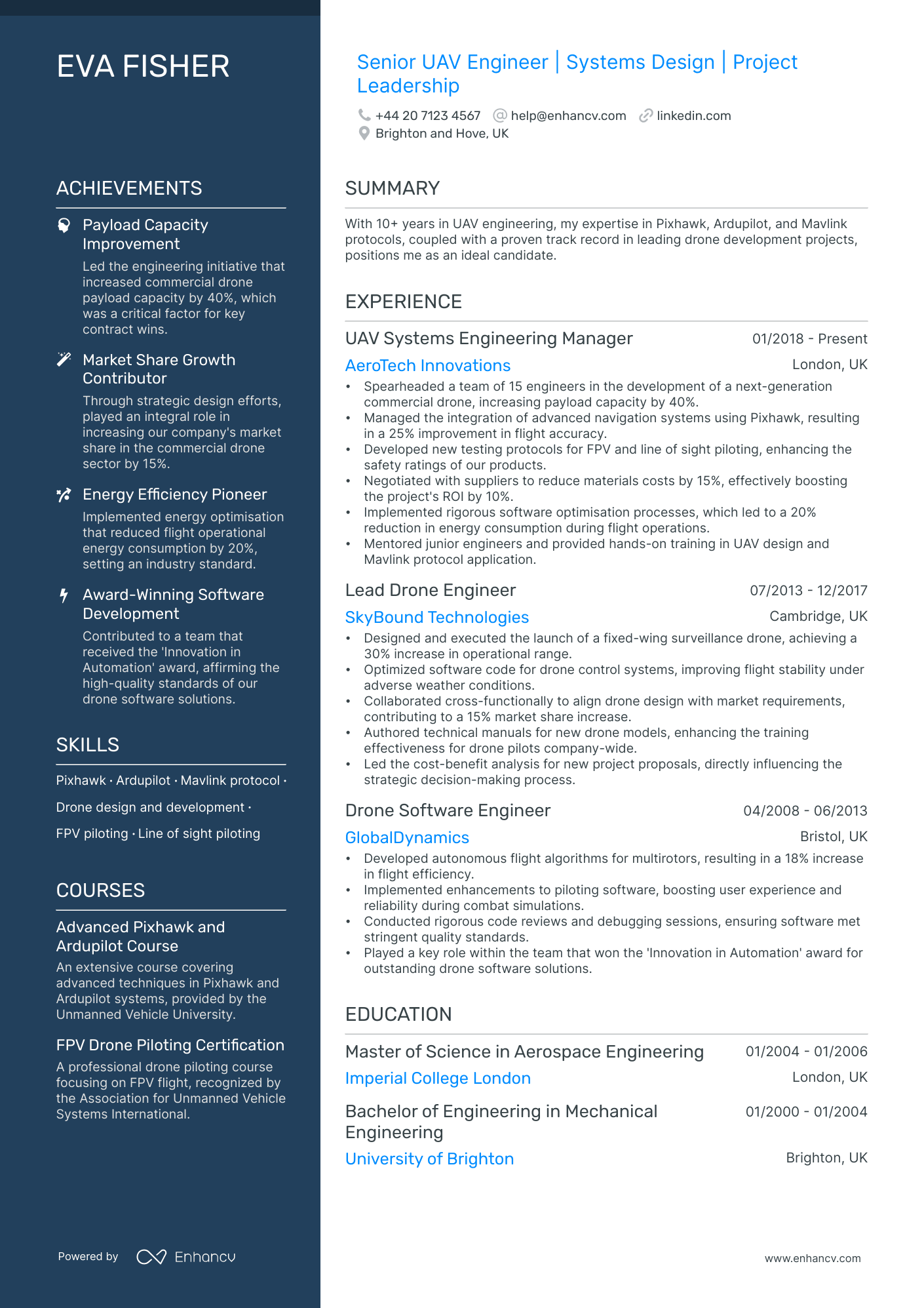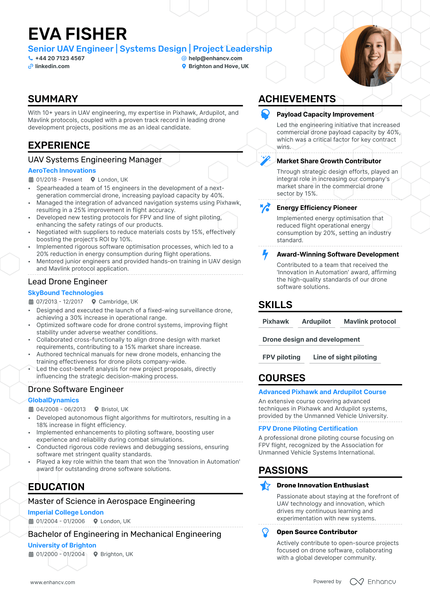Crafting a CV that effectively showcases your aviation experience and technical skills is a daunting challenge for many pilots seeking competitive roles. By following our guide, you'll gain insights on how to highlight your unique qualifications and flight hours, ensuring your CV stands out to potential employers.
- Applying the simplest CV design, so that recruiters can easily understand your expertise, skills, and professional background;
- Ensuring you stand out with your header, summary or objective statement, and a designated skills section;
- Creating your CV experience section - no matter how much expertise you have;
- Using real life professional CV examples to enhance the structure and outline of your profile.
If you still have no muse to write your professional CV, find some more industry-leading examples.
How to ensure your profile stands out with your pilot CV format
It's sort of a Catch 22. You want your pilot CV to stand out amongst a pile of candidate profiles, yet you don't want it to be too over the top that it's unreadable. Where is the perfect balance between your CV format simple, while using it to shift the focus to what matters most. That is - your expertise. When creating your pilot CV:- list your experience in the reverse chronological order - starting with your latest roles;
- include a header with your professional contact information and - optionally - your photograph;
- organise vital and relevant CV sections - e.g. your experience, skills, summary/ objective, education - closer to the top;
- use no more than two pages to illustrate your professional expertise;
- format your information using plenty of white space and standard (2.54 cm) margins, with colours to accent key information.
Once you've completed your information, export your pilot CV in PDF, as this format is more likely to stay intact when read by the Applicant Tracker System or the ATS. A few words of advice about the ATS - or the software used to assess your profile:
- Generic fonts, e.g. Arial and Times New Roman, are ATS-compliant, yet many candidates stick with these safe choices. Ensure your CV stands out by using a more modern, and simple, fonts like Lato, Exo 2, Volkhov;
- All serif and sans-serif fonts are ATS-friendly. Avoid the likes of fancy decorative or script typography, as this may render your information to be illegible;
- Both single- and double-column formatted CVs could be assessed by the ATS;
- Integrating simple infographics, icons, and charts across your CV won't hurt your chances during the ATS assessment.
PRO TIP
Use bold or italics sparingly to draw attention to key points, such as job titles, company names, or significant achievements. Overusing these formatting options can dilute their impact.
The top sections on a pilot CV
- Flight Hours Detailing Experience to show the extensive flying experience and types of aircraft handled.
- Licenses and Certifications to present the mandatory qualifications for piloting.
- Aviation Education to highlight formal training and relevant educational background.
- Work History in Aviation to outline past roles and responsibilities as a pilot.
- Medical Certificate Status to reassure the recruiter of the pilot's health for duty.
What recruiters value on your CV:
- Include your flight hours and types of aircraft you are experienced with at the top of your CV, as these are key qualifications for a pilot's role.
- Detail your aviation certifications, such as Airline Transport Pilot Licence (ATPL), Commercial Pilot Licence (CPL), or instrument rating, as they are crucial credentials.
- List all pertinent training and recency, such as simulator sessions, emergency procedures, and any other type-specific training to demonstrate current competence.
- Highlight any experience with international regulations and airspace, as well as language proficiency, which is valuable for communication and navigation in different countries.
- Emphasise leadership and teamwork skills through examples of crew coordination, mentoring, or incident management to show you are well-suited for the responsibilities of a pilot.
Recommended reads:
What information should you include in your pilot CV header?
The CV header is potentially the section that recruiters would refer to the most, as it should include your:
- Contact details - your professional (non-work) email address and phone number;
- Professional photograph - if you're applying hinting at the value you bring as a professional.
Many professionals often struggle with writing their pilot CV headline. That's why in the next section of this guide, we've curated examples of how you can optimise this space to pass any form of assessment.
Examples of good CV headlines for pilot:
- Captain | Wide-body Aircraft Specialist | ATPL Holder | Aviation Safety Advocate | 12+ Years' Experience
- Senior First Officer | Narrow-body Fleet Expert | Type Rated: A320 Family | Crew Leadership Skills | 8 Years' Flight Time
- Chief Pilot | Flight Training Design | Compliance & Regulations Expert | TRI/TRE | 15+ Years in Aviation
- Commercial Pilot | Regional Jet Experience | Advanced Navigation Techniques | Multi-Engine IFR Rated | 5+ Years Flying
- Helicopter Pilot | SAR Operations Lead | Offshore & HEMS Proficient | Night Vision Goggle Qualified | 10 Years' Service
- First Officer | Turboprop Specialist | Flight Operations Management | Cross-Cultural Communication | 6 Years' Airline Experience
Opting between a pilot CV summary or objective
Within the top one third of your pilot CV, you have the opportunity to briefly summarise your best achievements or present your professional goals and dreams. Those two functions are met by either the CV summary or the objective.
- The summary is three-to-five sentences long and should narrate your best successes, while answering key requirements for the role. Select up to three skills which you can feature in your summary. Always aim to present what the actual outcomes were of using your particular skill set. The summary is an excellent choice for more experienced professionals.
- The objective is more focused on showcasing your unique value as a candidate and defining your dreams and ambitions. Think about highlighting how this current opportunity would answer your career vision. Also, about how you could help your potential employers grow. The objective matches the needs of less experienced candidates, who need to prove their skill set and, in particular, their soft skills.
Still not sure about how to write your CV opening statement? Use some best industry examples as inspiration:
CV summaries for a pilot job:
Narrating the details of your pilot CV experience section
Perhaps you've heard it time and time again, but, how you present your experience is what matters the most. Your CV experience section - that details your work history alongside your accomplishments - is the space to spotlight your unqiue expertise and talents. So, avoid solely listing your responsibilities, but instead:
- adverts' keywords and integrate those in your experience section;
- Use your CV to detail how you've been promoted in the past by including experience in the reverse chronological order.
Before you start writing your pilot CV experience section, dive into some industry-leading examples on how to structure your bullets.
Best practices for your CV's work experience section
- Detail your total flight hours, making sure to break down your experience by aircraft type and any specific roles, such as Pilot-in-Command or Second-in-Command.
- Highlight your experience with different aviation technologies and instruments, including any modern glass cockpit systems or aviation software you are proficient with.
- Include your certifications and ratings, specifying the level of your pilot's licence, and list any additional qualifications such as instrument or multi-engine ratings.
- Describe any emergency situations you have successfully managed, showcasing your ability to remain calm under pressure and execute protocols efficiently.
- Emphasize your experience in various operational environments, such as international flights, cargo operations, or unique geographic regions that demonstrate adaptability.
- Mention any leadership roles or training responsibilities you've had, including mentoring junior pilots or leading crew briefings, to show management potential.
- Outline your experience with safety audits or compliance checks, stressing your commitment to maintaining high safety standards and adherence to regulations.
- Reference any experience you have had with different aviation sectors, such as commercial, corporate, charter, or military, to provide a holistic view of your background.
- Summarize any notable achievements in your career, such as awards, recognitions, or successful projects that have contributed to operational improvements or cost savings.
- Conducted over 500 international flights with a focus on cross-continental routes, maintaining a stellar on-time departure record of 98%.
- Played a pivotal role in implementing an improved fuel management system, which reduced fuel consumption by 5% per annum, achieving significant cost savings.
- Mentored junior pilots, enhancing team skill levels and driving performance standards, leading to a 10% improvement in flight operation efficiency.
- Led the successful certification process for a new aircraft type within the fleet, ensuring compliance with the strict regulatory standards of the Civil Aviation Authority.
- Expertly handled over 300 emergency and abnormal situations in-flight without incident, maintaining the highest safety standards and passenger confidence.
- Developed and executed training modules for autopilot systems, increasing overall pilot proficiency and reducing manual intervention by 15%.
- Piloted over 800 domestic flights with an emphasis on maximizing operational efficiency, leading to a 10% increase in on-time arrivals.
- Spearheaded a customer service initiative aimed at enhancing passenger experience, culminating in a 25% boost in customer satisfaction ratings.
- Collaborated with maintenance teams to reduce aircraft turnaround time by 20%, effectively increasing daily flight capacity.
- Responsible for the safe transport of over 1.2 million passengers, solidifying the company's reputation for safety and reliability.
- Innovated navigational route planning, resulting in a 7% decrease in average flight times while maintaining adherence to air traffic control guidelines.
- Coordinated multi-disciplinary teams during several critical aircraft retrofit projects, ensuring on-time delivery within budget constraints.
- Played a key role in the company's expansion by successfully inaugurating 15 new international routes, securing a competitive market share.
- Reduced incident rate by 30% through focused leadership and by fostering a culture of continuous safety improvement among the flight crew.
- Leveraged advanced avionics technology to optimize flight paths, saving an estimated 50,000 gallons of jet fuel annually.
- Orchestrated the transition to paperless cockpit operations, streamlining information management and resulting in a 20% reduction in administrative workload for pilots.
- Championed a flight data analysis program that improved overall aircraft performance and crew response times during critical flight phases.
- Directed cross-functional teams through a series of technical upgrades across the fleet, ensuring seamless integration of new navigation systems.
- Implemented a stringent risk assessment protocol that led to a 70% reduction in flight delays due to technical issues, streamlining operations significantly.
- Cultivated a safety-first culture that surpassed industry standards, achieving a record-setting period of 3 years without an on-board incident.
- Optimized crew scheduling to enhance work-life balance, achieving a 15% improvement in crew satisfaction without compromising service levels.
- Initiated and managed a comprehensive environmental program aimed at reducing the airline's carbon footprint, which cut CO2 emissions by 12%.
- Oversaw in-flight testing for new avionic systems, contributing to the advancement of navigational accuracy and communication technology.
- Conducted VIP transport missions with zero security or safety breaches, bolstering the airline's status for high-profile service.
Lacking professional expertise: how to write your CV to highlight your best talents
Don't count on your lucky stars when you're applying for a role, where you happen to have less (or almost none) professional experience. Recruiters sometimes do hire inexperienced candidates if they're able to present their unique value from the get-go. So, instead of opting for the traditional, CV experience section:
- List any applicable expertise you happen to have - no matter if it's a part-time job, internship, or volunteer work. This would hint to recruiters that your profile is relevant;
- Focus your CV on your transferrable skills or talents you've obtained thanks to your whole life and work experience. In effect, you'll be spotlighting your value as a candidate;
- Separate more space for your applicable academic background and certificates to show you have the technical know-how;
- Ensure that within your objective, you've defined why you'll like the job and how you'll be the perfect match for it. Always ensure you've tailored your CV to individual applications.
Looking for more good examples for your first job? We'll show you how other candidates, with less professional experience, have created their job-winning CVs.
Recommended reads:
PRO TIP
Describe how each job helped you grow or learn something new, showing a continuous development path in your career.
Mix and match hard and soft skills across your pilot CV
Your skill set play an equally valid role as your experience to your application. That is because recruiters are looking for both:
- hard skills or your aptitude in applying particular technologies
- soft skills or your ability to work in a team using your personal skills, e.g. leadership, time management, etc.
Are you wondering how you should include both hard and soft skills across your pilot CV? Use the:
- skills section to list between ten and twelve technologies that are part of the job requirement (and that you're capable to use);
- strengths and achievements section to detail how you've used particular hard and soft skills that led to great results for you at work;
- summary or objective to spotlight up to three skills that are crucial for the role and how they've helped you optimise your work processes.
One final note - when writing about the skills you have, make sure to match them exactly as they are written in the job ad. Take this precautionary measure to ensure your CV passes the Applicant Tracker System (ATS) assessment.
Top skills for your pilot CV:
Aircraft handling
Navigation
Aerodynamics
Meteorology
Flight planning
Air traffic control communication
Emergency procedures
Technical understanding of aircraft systems
Instrumentation proficiency
Regulatory compliance
Decision making
Situational awareness
Problem-solving
Leadership
Communication
Teamwork
Stress management
Adaptability
Attention to detail
Self-discipline
PRO TIP
If you have received professional endorsements or recommendations for certain skills, especially on platforms like LinkedIn, mention these to add credibility.
Your university degree and certificates: an integral part of your pilot CV
Let's take you back to your uni days and decide what information will be relevant for your pilot CV. Once more, when discussing your higher education, select only information that is pertinent to the job (e.g. degrees and projects in the same industry, etc.). Ultimately, you should:
- List only your higher education degrees, alongside start and graduation dates, and the university name;
- Include that you obtained a first degree for diplomas that are relevant to the role, and you believe will impress recruiters;
- Showcase relevant coursework, projects, or publications, if you happen to have less experience or will need to fill in gaps in your professional history.
PRO TIP
Focus on describing skills in the context of the outcomes they’ve helped you achieve, linking them directly to tangible results or successes in your career.
Recommended reads:
Key takeaways
Impressing recruiters with your experience, skill set, and values starts with your professional pilot CV. Write concisely and always aim to answer job requirements with what you've achieved; furthermore:
- Select a simple design that complements your experience and ensures your profile is presentable;
- Include an opening statement that either spotlights your key achievements (summary) or showcases your career ambitions (objective);
- Curate your experience bullets, so that each one commences with a strong, action verb and is followed up by your skill and accomplishment;
- List your hard and soft skills all across different sections of your CV to ensure your application meets the requirements;
- Dedicate space to your relevant higher education diplomas and your certificates to show recruiters you have the necessary industry background.
